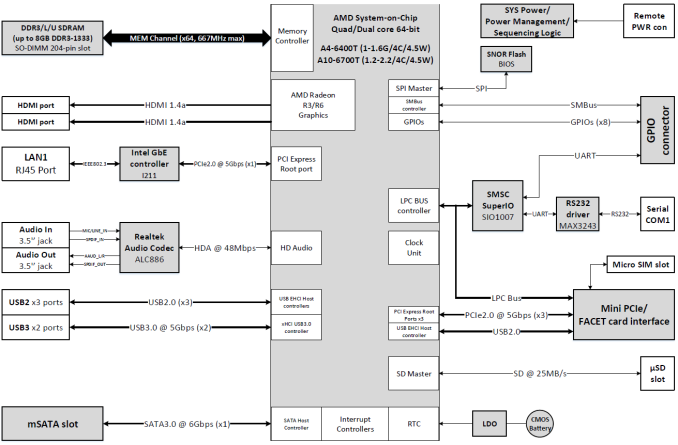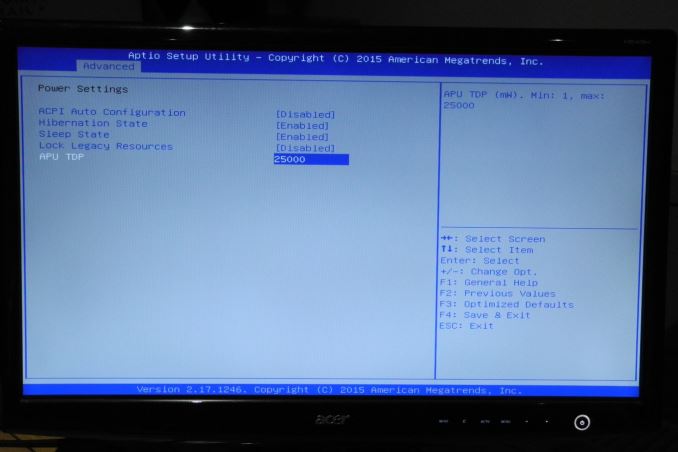Compulab fitlet-XA10-LAN Review: A Fanless AMD UCFF PC for Networking Applications
by Ganesh T S on April 19, 2016 8:00 AM EST- Posted in
- Systems
- Networking
- AMD
- Fanless
- Industrial PC
- Passive Cooling
- CompuLab
Hardware Aspects and BIOS Features
Our review kit came with four different components - the two main units, a fit-Uptime UPS and the heat-sink. The gallery below shows their different external aspects. The fit-Uptime contains a 18Wh Li-Po (lithium-polymer) battery that can deliver up to 60W (12V @ 5A) of power in case of power input failure. It needs an input of 12V @ 1A minimum to recharge itself. The aspect I like most about the fit-Uptime as well as the power adapter bundled with the fitlet units is the notch on the power delivery pin. Inserting it into the power input of the fitlet and twisting it around ensures that the power cord can never be accidentally yanked away from the PC. Obviously, the fit-Uptime is not network or USB-capable. Hence, it is not possible to determine how much charge is remaining in the internal battery at any point of time. Additionally, the target PC has no idea whether it is running on the mains or the fit-Uptime. However, this is not a concern if power failure is accidental / of short duration.
Despite the top lid being aluminum, the front and rear panels are made of plastic. Unfortunately, this makes the unit feel a little cheap in hand, but, as we found out later, it doesn't affect the thermal performance of the unit. On the front panel, we have the power button with a LED indicator, a USB 3.0 and two USB 2.0 ports, a micro-SD slot and 3.5mm audio jacks (surprisingly, not a combo audio jack, but separate ones for the headphone and microphone). One of the side panels is an extension of the top lid, and helps in securing it to the rest of the system. The rear panel has one USB 2.0 and one USB 3.0 port, two HDMI 1.4a ports and a RJ-45 port. A COM port is also available, and a serial port adapter is supplied along with the main unit. The other side panel is the face of the FACET card, and, in our case, it has the three extra LAN ports.
Getting into the internals of the unit is fairly simple, and Compulab even has video instructions for the same. Removing the bottom panel of our review unit revealed the back side of the FC-LAN FACET card. Underneath the top panel, we have a big chunk of metal covering the SoC. Though this metal chunk does come in contact with the top panel, there is no thermal paste involved. The SODIMM slot is also found under the top panel.
Moving back to the other side of the board, we find that it is easy to slide out the FACET card. This reveals a metal plate to create isolation between the mSATA card and the FC-LAN card. The CMOS battery as well as the micro-SIM slot are also accessible on this side. Changing the mSATA card is also fairly trivial, and involves the removal of just a couple of screws (one attaching the mSATA card to the metal plate, and another securing it to the motherboard). The gallery below shows our disassembly process, as well as the replacement of the original lid with the finned heat-sink version.
The block diagram of the motherboard with details of the I/O distribution is shown below.
The AMI BIOS has plenty of configuration tweaks available. The most important is the configurable TDP. This can be set between 1mW and 25W. Setting it to the maximum value is equivalent to completely unlocking the TDP limitations. By default, these values are set to 4500. However, both our units were configured for unlocked TDP. Compulab indicated that their currently shipping thermal solution is good enough to safely set the APU TDP to 25W.
Other configurable aspects include the memory dedicated to the GPU, SDIO access mode, fast boot configuration and security options (including key management for secure boot).






























50 Comments
View All Comments
ingwe - Tuesday, April 19, 2016 - link
This may be a naive question, but would this work as an HTPC? I would love a fanless solution for that and this seems to offer decent performance.monstercameron - Tuesday, April 19, 2016 - link
h.264 8bit 1080p, it could work but dont expect super high bit rates to work.unproven - Tuesday, April 19, 2016 - link
The ancient Zbox Nano AQ01 with an A4-5000 runs my 1080 display flawlessly - never a decoding single while streaming, including every H265 file I've tried.Old low power cores lack in ST performance so interfaces don't always "snap", but this thing should have no troubles at all with FHD TV.
BurntMyBacon - Tuesday, April 19, 2016 - link
Performance-wise it could be used as an HTPC. That said, you'd be better off considering a different variation of the fitlet unless you have a pressing need for all the networking ports.Caveats: The fitlets I had got VERY hot. I found the same results over multiple units and more than one variation of the fitlet, so I don't believe it to be a one off issue. I put them on top of mesh shelving and ran a fan on them as they would discolor the surface of the shelve they sat on over time. They had shallow fins on the top, so I believe they were second revision. The new heatsink may fix this problem.
That all said, you'd probably be better off looking at some of the other offerings from the same company. My experience with the Intense-PC3 and Intense-PC4 have been very positive. They aren't as small as fitlets, but they are still smaller than many consumer grade routers and they don't have the heat issues.
BurntMyBacon - Tuesday, April 19, 2016 - link
Correction - I've had positive experiences with the Fit-PC3 and Fit-PC4. Haven't had the pleasure of using an Intense-PC.ct909 - Tuesday, April 19, 2016 - link
An Intel NUC might not be fanless, but I'm damned if I can ever hear it, and would be a much better HTPC. You could even consider an Intel compute-stick.at80eighty - Tuesday, April 19, 2016 - link
look at the Minix NEO U1 - fanless; 4k, 60fps, 10bit, HEVCraddude9 - Thursday, April 21, 2016 - link
I would look at a different model of the Fitlet for HTPPC purposes. They have a version with just one Ethernet port for $15 less and one with the slightly slower A4 Micro-6400T chip for $69 less. Both of those probably put out less heat so would be more suitable for HTPC applications.Compulab - Thursday, April 21, 2016 - link
6400T is indeed significantly lower cost than 6700T, but for a given workload the 6700T would be lower-power since for a given frequency it can run at lower core voltage.pekpetrolhead - Friday, April 22, 2016 - link
Youy might want to consider a Giada F300. Fanless (whole chassis is a heatsink), i5 - great unit allround.